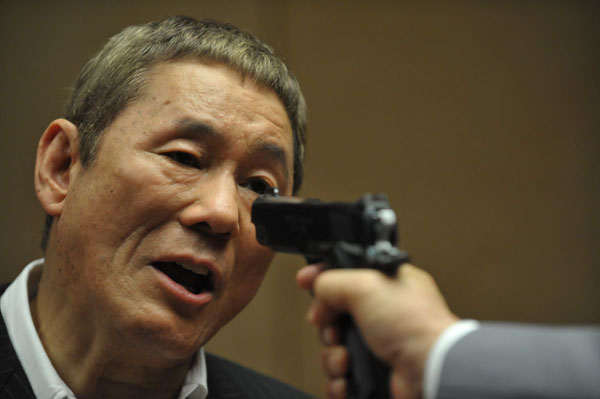“Kitano Takeshi’s best film in a decade or so, Outrage Beyond is to the pretty lousy Outrage (2010) as Johnnie To’s career-capper Election 2 (2006) is to Election (2005),” writes Cinema Scope editor Mark Peranson. “Ultra-sparse, tough as nails, and wavering between droll and laugh-out-loud funny, Outrage Beyond begins five years after the events of the first film, quickly establishing the corporatization of the yakuza, who, like Japan, have fallen on hard financial times. Tokyo’s Sanno clan is now lorded over by Kato and his slick, younger underboss Ichihara; a restructuring of the executive board is underway, with a merit-based system that benefits those with hedge fund-managing experience. Backroom machinations, secret alliances, backstabbing (well, back-shooting)—to a certain extent, it remains business as usual, and a deliberate build-up that is more than a bit confusing for everyone who missed Outrage, let alone those of us who had to sit through it.” Still: “The conclusion is extremely satisfying.”
“Devotees awaiting a return to the brilliantly idiosyncratic form of Takeshi Kitano’s best work, like Sonatine and Hana-bi, will have to keep hoping,” finds the Hollywood Reporter‘s David Rooney. “Kitano has been making unconventional yakuza and cop films for more than two decades so it’s not surprising that his focus would graduate now to shifting styles of operation on both sides of the law. Much is made here of the erosion of traditional codes of honor and family loyalty, with disgruntled old-school mobsters being pushed aside for young hedge-fund hot shots. They run the Sanno organization much like a corporate entity, while the alter kockers grumble quietly about such things as meals no longer being served at executive meetings. It’s a droll vision of organized crime, and worlds apart from, say, the American, Italian or Russian equivalents. Women barely enter the picture here.”
“It’s a monotonous, oppressive world by design, appointed with spare precision by Norihiro Isoda and lensed in studiously underlit widescreen tableaux by Katsumi Yanagijima.” Variety‘s Justin Chang: “The overall formal elegance extends to the meticulous manner in which bodies are blocked and choreographed within the frame, whether standing stiff-backed or keeling over. But too much of what unfolds here simply doesn’t reward prolonged scrutiny; the film is essentially a slow-motion deathtrap in which the wall-to-wall chatter feels like a joyless, too-leisurely distraction from the inevitable bloodletting.”
“Outrage Beyond brings two fresh ideas to the yakuza table,” finds Screen‘s Lee Marshall: “the first is the idea of the clans as companies that feature the same levels of inefficiency, bureaucracy and in-fighting as their legitimate equivalents. The second is to bring a policeman into the mix, not as heroic crimebuster but as a sly manipulator of clan alliances. The world that Kitano paints here is one in which codes of honor are challenged by a new kind of realpolitik, both within the clans and the forces of law and order.” All in all, it’s “a film that always has humor bubbling just underneath its hard-boiled surface.”
Adam Woodward in Little White Lies: “As its title suggests, Outrage Beyond is bigger, slicker and shoutier than its predecessor, with a body count to satisfy the most voracious action fan and an ending that’s executed to absolute perfection.”
Outrage Beyond‘s screened in Competition in Venice and will be a Special Presentation in Toronto.
Update, 9/10: “While it has all the trappings of the middle chapter of what’s bound to be a trilogy, the film is a worthy follow-up to Outrage and more of the excellent Japanese action we’ve come to expect from Kitano,” writes Ryland Aldrich at Twitch.
Update, 9/23: “I quickly got lost in its labyrinth of clans, bosses, henchmen and cops,” writes Fernando F. Croce in MUBI’s Notebook, “though I doubt my confusion was due only to festival exhaustion; not unlike Jean-Pierre Melville, Kitano deliberately sees crime gangs as interchangeable entities in an unending Möbius strip of tableaux shattered by bullets and knives. Even when applying a power drill to an enemy thug or making grisly use of a baseball batting cage, his camerawork is here at its most classical.”
Venice and Toronto 2012: a guide to the coverage of the coverage. For news and tips throughout the day every day, follow @KeyframeDaily on Twitter and/or the RSS feed. Get Keyframe Daily in your inbox by signing in at fandor.com/daily.




